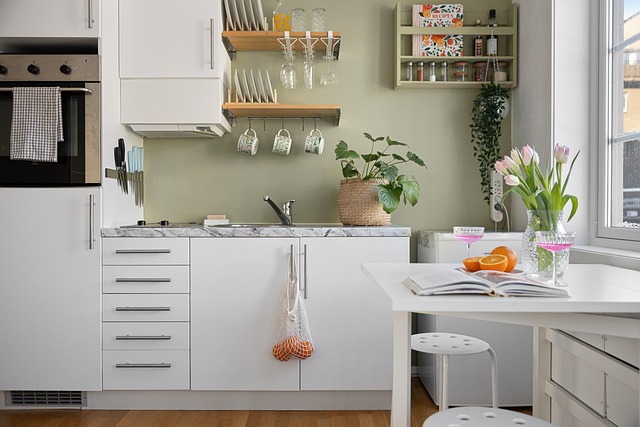In today's world, preparing a disaster-proof home is essential for protecting your family and property from natural disasters like hurricanes, floods, wildfires, and earthquakes. Start by identifying regional hazards and implementing specific strategies: use robust materials for siding, install impact-resistant windows, and ensure water intrusion prevention. Upgrades such as smart home systems with flood sensors, storm shutters, fire-resistant materials, and a stocked safe room further enhance protection. Technology, like smart insulation and atmospheric monitoring, offers advanced solutions to make homes more resilient. Investing in these measures ensures peace of mind and significantly reduces disaster impact.
In an era where natural disasters are becoming increasingly frequent and severe, safeguarding your home is more crucial than ever. This article explores the concept of disaster-proofing your abode, delving into essential enhancements that fortify its exterior and interior against the elements. From robust materials to cutting-edge technology, we uncover smart upgrades that promise peace of mind during turbulent times. Get ready to transform your house into a resilient fortress.
- Understanding Disaster-Proofing: Why It Matters for Your Home
- Essential Features of a Weather-Resistant Exterior
- Smart Upgrades to Protect Against Natural Disasters
- Interior Preparations: Ensuring Safety and Comfort During Severe Weather
- Technology's Role in Creating a Resilient Home
Understanding Disaster-Proofing: Why It Matters for Your Home

In today’s world, where natural disasters are becoming increasingly frequent and severe, ensuring your home is disaster-proof is no longer a consideration but a necessity. A disaster-proof home is designed to withstand and minimize damage from various elements such as hurricanes, floods, wildfires, and earthquakes. This proactive approach not only safeguards your family’s safety but also protects your investment in your home.
Understanding the specific risks in your area is the first step towards making your home disaster-resistant. For instance, homeowners in coastal regions should focus on reinforcing against strong winds and rising sea levels, while those in fire-prone areas need to implement measures to prevent rapid fire spread. Regular maintenance and upgrades are key; from securing loose shingles to installing impact-resistant windows, these seemingly small steps can make a significant difference when disaster strikes.
Essential Features of a Weather-Resistant Exterior

When enhancing your home for weather resistance, focus on key exterior features that act as a first line of defense against the elements. A disaster-proof home starts with robust materials designed to withstand high winds, heavy rainfall, and extreme temperatures. Consider siding options like hurricane-resistant board, fiber cement, or stone—all known for their durability and impact resistance.
Additionally, ensure your exterior includes features that prevent water intrusion. This includes well-installed gutters and downspouts to direct rainwater away from the foundation, along with weatherstripping around doors and windows to seal out drafts and moisture. A waterproof barrier on exterior walls and a strong roof underlayment are also vital components in creating a home that can stand up to challenging weather conditions.
Smart Upgrades to Protect Against Natural Disasters

When considering weather-resistant home enhancements, transforming your residence into a disaster-proof haven is a smart and proactive approach. Upgrading your home with robust materials and advanced technology can significantly mitigate the impact of natural disasters, from harsh storms to intense earthquakes. For instance, installing impact-resistant windows and doors made from reinforced polycarbonate or steel can withstand extreme winds and flying debris, providing crucial protection for your family and belongings during hurricanes or tornadoes.
Additionally, integrating smart home systems with flood-sensing sensors and automatic shut-off valves allows for swift action in case of rising water levels. These technologies not only safeguard your home but also minimize potential damage to your property and personal possessions. By investing in these smart upgrades, you’re taking a significant step towards ensuring your peace of mind and the safety of your loved ones during unforeseen weather events.
Interior Preparations: Ensuring Safety and Comfort During Severe Weather

To prepare your home interior for severe weather, start by reinforcing structural weaknesses. This could involve adding extra support to roofs and windows, which are often vulnerable points during storms. Storm shutters or impact-resistant windows can significantly enhance a disaster-proof home, safeguarding against flying debris and reducing damage from high winds. Ensure proper ventilation to prevent rot and mold growth, especially in areas prone to flooding or high humidity.
Implementing smart technology can further boost your interior’s resilience. Smart floodlights and sensors can alert you to rising water levels or potential leaks, allowing for quick action. Fire-resistant materials and sprinkler systems are also valuable investments, as they protect against two of the most common perils that severe weather can bring. Lastly, consider creating a safe room or designated shelter area within your home, stocked with essential supplies, to ensure safety and comfort during extreme weather events.
Technology's Role in Creating a Resilient Home

In today’s digital era, technology plays a pivotal role in enhancing homes’ resilience against the elements and potential disasters. Smart home systems have emerged as game-changers, offering homeowners advanced monitoring and control capabilities. These systems can detect changes in atmospheric conditions, such as sudden temperature drops or rising humidity levels, which might indicate an impending storm. Through connected devices, homeowners receive real-time alerts, enabling them to take proactive measures like securing windows and doors or moving valuable items to safer locations.
Moreover, technological innovations like weather-resistant exterior finishes and smart insulation ensure a disaster-proof home. Advanced materials can withstand harsh weather conditions, reducing the risk of damage from wind, rain, or snow. Smart insulation, equipped with sensors, helps maintain optimal indoor temperatures, preventing thermal shocks that could compromise structural integrity during extreme weather events. By integrating these technological solutions, homeowners can create a robust defense against natural calamities, enhancing their safety and peace of mind.
In conclusion, creating a disaster-proof home is not just about enhancing aesthetics but ensuring your family’s safety and security. By understanding the essential features of a weather-resistant exterior, implementing smart upgrades, and preparing both indoors and out, you can significantly reduce the impact of natural disasters. Technology plays a pivotal role in this process, offering innovative solutions to protect your home and preserve your peace of mind. Remember, a well-prepared disaster-proof home is a resilient home, ready to withstand any weather.
